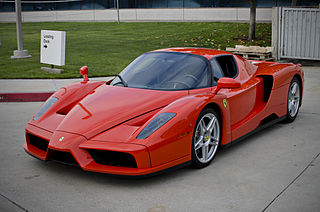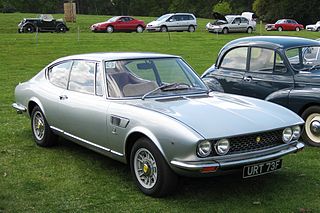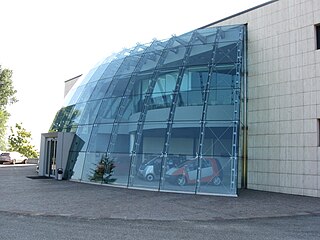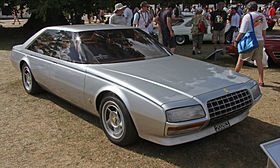
Ferrari S.p.A. is an Italian luxury sports car manufacturer based in Maranello, Italy. Founded by Enzo Ferrari in 1939 out of the Alfa Romeo race division as Auto Avio Costruzioni, the company built its first car in 1940, and produced its first Ferrari-badged car in 1947.

Maserati S.p.A. is an Italian luxury vehicle manufacturer. Established on 1 December 1914, in Bologna, Italy, the company's headquarters are now in Modena, and its emblem is a trident. The company has been owned by Stellantis since 2021. Maserati was initially associated with Ferrari. In May 2014, due to ambitious plans and product launches, Maserati sold a record of over 3,000 cars in one month. This caused them to increase production of the Quattroporte and Ghibli models. In addition to the Ghibli and Quattroporte, Maserati offers the Maserati GranTurismo, the Maserati Levante. Maserati has placed a production output cap at 75,000 vehicles globally.

Dino was a marque best known for mid-engined, rear-drive sports cars produced by Ferrari from 1957 to 1976. The marque came into existence in late 1956 with a front-engined Formula Two racer powered by a brand new Dino V6 engine. The name Dino was used for some models with engines smaller than 12 cylinders, it was an attempt by the company to offer a relatively low-cost sports car. The Ferrari name remained reserved for its premium V12 and flat-12 models until 1976, when "Dino" was retired in favour of full Ferrari branding.

The Ferrari Berlinetta Boxer (BB) is a sports car that was produced by Ferrari in Italy between 1973 and 1984. Replacing the front engined Daytona, it was the first in a series of Ferraris to use a mid-mounted flat-twelve engine. The Boxer was designed by Leonardo Fioravanti and was the first mid-engined road-car to bear the Ferrari name and the Cavallino Rampante logo. It was replaced by the Testarossa, which continued to use the flat-twelve engine.

The Enzo Ferrari is a mid-engine sports car manufactured by Italian automobile manufacturer Ferrari and named after the company's founder, Enzo Ferrari. It was developed in 2002 using Formula One technology, such as a carbon-fibre body, F1-style automated-shift manual transmission, and carbon fibre-reinforced silicon carbide (C/SiC) ceramic composite disc brakes, as well as technologies not allowed in F1, such as active aerodynamics. The Enzo Ferrari generates substantial amounts of downforce through its front underbody flaps, small adjustable rear spoiler and rear diffuser, which work in conjunction to produce 3,363 newtons (756 lbf) of downforce at 200 km/h (124 mph) and 7,602 newtons (1,709 lbf) of downforce at 299 km/h (186 mph), before decreasing to 5,738 N (1,290 lbf) at top speed.

The Fiat Dino was a front-engine, rear-wheel-drive sports car produced by Fiat from 1966 to 1973. The Dino name refers to the Ferrari Dino V6 engine, produced by Fiat and installed in the cars to achieve the production numbers sufficient for Ferrari to homologate the engine for Formula 2 racing.

Ferrari America is a series of top-end Ferrari models built in the 1950s and 1960s. They were large grand touring cars with the largest V12 engines and often had custom bodywork. All America models used a live axle in the rear, were front-engined, and had worm and sector steering.

The Ferrari 250 is a series of sports cars and grand tourers built by Ferrari from 1952 to 1964. The company's most successful early line, the 250 series includes many variants designed for road use or sports car racing. 250 series cars are characterized by their use of a 3.0 L (2,953 cc) Colombo V12 engine designed by Gioacchino Colombo. They were replaced by the 275 and 330 series cars.

The Maserati Quattroporte is a four-door full-size luxury sports saloon produced by Italian automobile manufacturer Maserati. The name translated from Italian means "fourdoors". The car is currently in its sixth generation, with the first generation introduced in 1963.

The Geneva International Motor Show is an annual auto show held in March in the Swiss city of Geneva. The show is hosted at the Palexpo, a convention centre located next to the Geneva Cointrin International Airport. The Salon is organised by the Organisation Internationale des Constructeurs d'Automobiles, and is considered an important major international auto show.

Pininfarina S.p.A. is an Italian car design firm and coachbuilder, with headquarters in Cambiano, Turin, Italy. It was founded by Battista "Pinin" Farina in 1930. On 14 December 2015, Mahindra Group acquired Pininfarina S.p.A. for about €168 million.

The Ferrari GTO is an exotic homologation of the Ferrari 308 GTB produced from 1984 to 1987 in Ferrari's Maranello factory, designated GT for Gran Turismo and O for Omologata.

Leonardo Fioravanti is an Italian automobile designer and CEO of Fioravanti Srl.

The Lancia Flaminia is a luxury car produced by Italian automaker Lancia from 1957 to 1970. It was Lancia's flagship model at that time, replacing the Aurelia. It was available throughout its lifetime as saloon, coupé and cabriolet. The Flaminia coupé and convertible were coachbuilt cars with bodies from several prestigious Italian coachbuilders. Four "presidential" stretched limousine Flaminias were produced by Pininfarina for use on state occasions.
Tom Tjaarda was an American automobile designer noted for his work on a broad range of automobiles — estimated at over eighty — from exotic sports cars including the Ferrari 365 California, De Tomaso Pantera and Aston Martin Lagonda Coupé to high-volume popular cars including the first generation Ford Fiesta (1972) and the Fiat 124 Spider (1966).
The Turin Motor Show was an auto show held annually in Turin, Italy. The first official show took place between 21 and 24 April 1900, at the Castle of Valentino, becoming a permanent fixture in Turin from 1938 having shared it with Milan and Rome until that time. From 1972, the show was held biannually and in 1984, it moved into Fiat's shuttered Lingotto factory.

Aldo Brovarone was an Italian automobile designer and the chief stylist with Carrozzeria Pininfarina (1974-1988) – widely known for a prominent range of work including the Dino 206 GT, Lancia Gamma Coupé and the Peugeot 504 (sedan).

The Ferrari 365 P Berlinetta Speciale was a concept sports car designed and produced by Pininfarina and Ferrari in 1966. It featured a mid-engined layout of a donor racing car chassis and three-seat arrangement with a central driving position, as later popularised on McLaren F1. It was the first purpose-built, mid-engined, road-going Ferrari-branded car. Other similar Ferraris at that time were road-usable race cars like the 250 LM 'Stradale'.

















